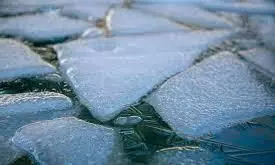
Melting arctic permafrost could unleash ancient zombie viruses, scientists
text_fieldsResearchers have issued a warning regarding the potential threat of viruses lying dormant beneath Arctic ice caps, posing a risk of a global health emergency if released due to the melting permafrost.
The dangers associated with these ancient viruses have heightened with the rise in temperatures linked to global warming, leading to the melting of frozen ice.
Geneticist Jean-Michel Claverie of Aix-Marseille University revived some of these viruses from samples obtained from Siberian permafrost last year to better comprehend the risks.
"At the moment, analyses of pandemic threats focus on diseases that might emerge in southern regions and then spread north. By contrast, little attention has been given to an outbreak that might emerge in the far north and then travel south - and that is an oversight, I believe. There are viruses up there that have the potential to infect humans and start a new disease outbreak," said Claverie.
Marion Koopmans of the Erasmus Medical Center in Rotterdam also emphasised the real risk of an ancient virus triggering a disease outbreak, citing the unknown viruses present in the permafrost. Live viruses, despite spending thousands of years frozen in permafrost, demonstrated the ability to infect single-celled organisms, as illustrated by Claverie's team in Siberia in 2014.
While the isolated viruses in the study posed no risk to humans, the concern lies in the possibility of other viruses, currently frozen in permafrost, having the potential to cause illnesses in humans. Genomic traces of poxviruses and herpesviruses, known human pathogens, have been identified in the permafrost.
Approximately a fifth of the Northern Hemisphere is covered in permafrost, serving as a time capsule preserving the remains of extinct creatures.
As global warming accelerates, the Arctic region is experiencing temperature increases several times faster than the global average. The disappearance of Arctic sea ice, allowing increased shipping, traffic, and industrial development in Siberia, poses a significant threat.
The planned mining operations in the region, extracting oil and ores, could release pathogens into the environment, potentially leading to severe consequences.























